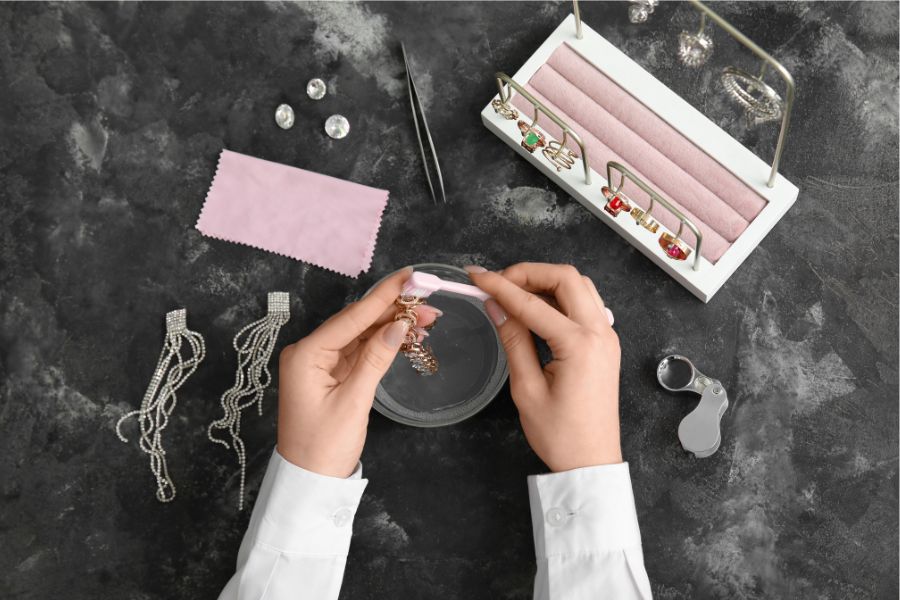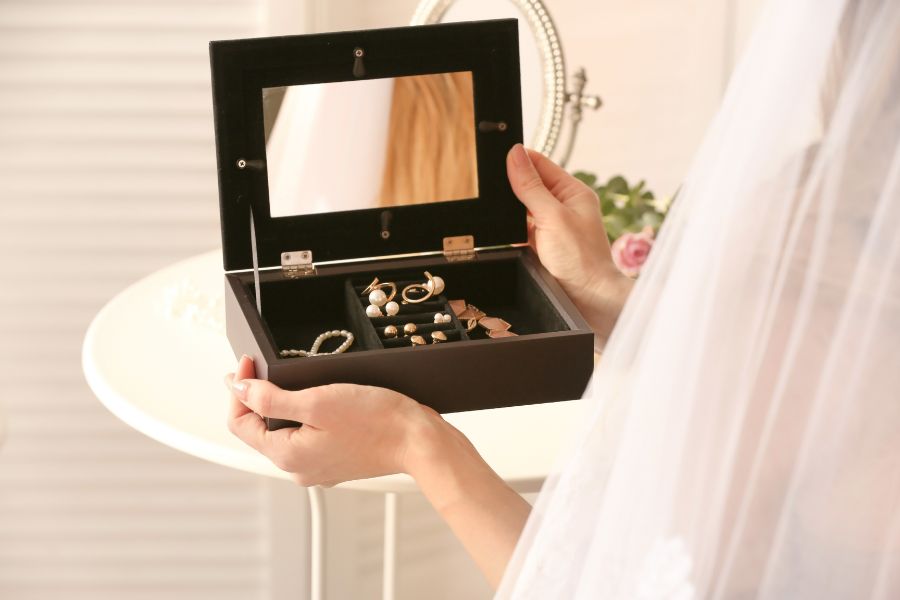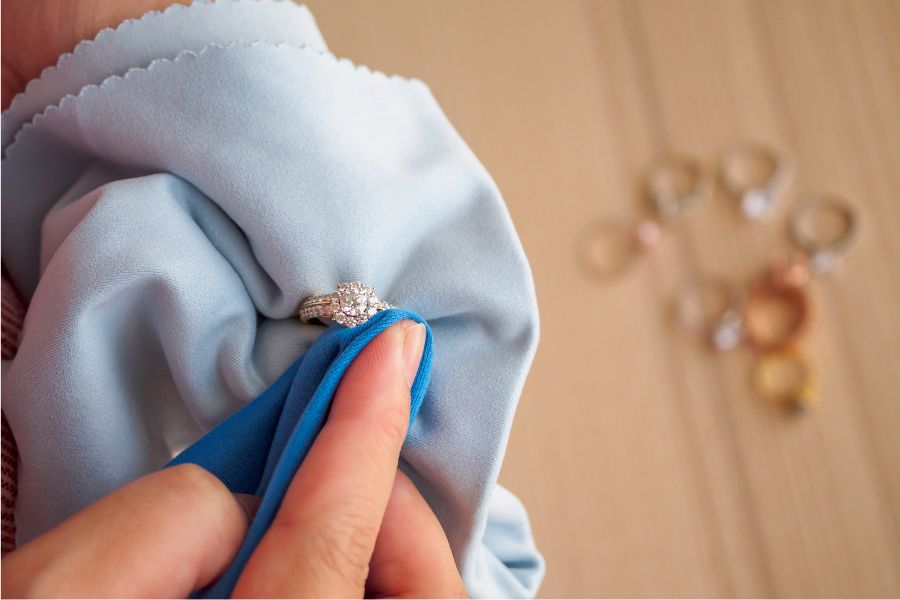Jewelry is more than just a fashion statement; it often holds sentimental value and represents personal milestones. Whether it's a gold bracelet passed down through generations or a new pair of silver earrings, taking proper care of your jewelry is crucial for preserving its beauty and extending its life.
In this guide, we'll cover the essentials of jewelry care, including how to clean, store, and maintain your cherished pieces.

Regular cleaning is essential to maintain your jewelry's appearance. However, each type of material needs its own cleaning method. Here's a guide to effectively clean different kinds of jewelry:
Gold jewelry is known for its durability, but it can lose its shine over time. To clean gold:
1.In a small bowl, mix a few drops of mild dish soap with some warm water.
2.Place the jewelry in the solution and let it soak for about 10-15 minutes.
3.Use a soft toothbrush to gently scrub the surface, paying close attention to intricate details.
4.Rinse thoroughly under warm running water and dry with a soft, lint-free cloth.
For extra shine, you can buff the jewelry with a polishing cloth designed for gold.
Silver jewelry can tarnish easily, leading to a dull, darkened appearance. To clean silver:
1.Mix warm water with a few drops of mild dish soap.
2.Dampen a soft cloth with the mixture and gently rub the silver jewelry. If the piece is heavily tarnished, make a paste using baking soda and water, and gently apply it with a soft cloth.
3.Rinse the jewelry with cool water and dry it thoroughly to prevent water spots.
4.Store silver jewelry in an anti-tarnish pouch to help maintain its shine.
Diamonds may be hard, but they still require careful cleaning to maintain their sparkle. To clean diamond jewelry:
1.Make a solution with warm water and mild dish soap.
2.Soak the diamond piece for 10-20 minutes to loosen any dirt or oils.
3.Use a soft toothbrush to clean around the setting and other hard-to-reach areas.
4.Rinse the jewelry under warm water and dry it with a lint-free cloth.
5.Avoid using harsh chemicals, as they can damage the metal setting.
Given their delicate nature, pearls require careful handling. After wearing them, gently wipe them with a soft, damp cloth to remove any oils or dirt. Avoid submerging pearls in water, as it can weaken the silk thread holding them together. If a deeper cleaning is necessary, dampen a cloth with a mild soap and water mixture, and carefully wipe each pearl. Ensure the pearls are fully air-dried before storing them in a soft pouch to prevent scratches.
Colored gemstones like sapphires, emeralds, and rubies require special care. Gently wipe the surface with a clean, soft cloth and avoid soaking the jewelry, especially if the gemstones are porous, as water can cause damage. If these gemstone jewelry are dampened, make sure the jewelry is fully dry before storing it to prevent any moisture-related harm to the stones or settings.

Proper storage is vital in preventing damage, such as scratches, tarnishing, or tangling. Here are some effective ways to store your jewelry:
A jewelry box with several compartments is perfect for organizing and safeguarding your pieces. Opt for a box that has a soft lining, such as velvet or felt, to help prevent scratches. Store each piece in its own compartment to keep them from rubbing against one another and causing damage.
Jewelry should be stored in a location that is cool, dry, and away from direct sunlight. Excessive heat and humidity can tarnish metals and dull gemstones. If you live in a humid climate, consider placing silica gel packets in your jewelry box to absorb moisture and protect your pieces.
Necklaces and bracelets with chains can easily become tangled if not stored properly. To avoid this, hang each chain on a hook or store it in a separate pouch or compartment. This method not only keeps chains untangled but also prevents them from getting kinked or broken.
Jewelry that is delicate or made from fragile materials, such as pearls or certain gemstones, should be stored in soft pouches or padded compartments. This extra cushioning helps prevent scratches and other forms of damage. Never stack your jewelry on top of one another, as this can lead to dents and unwanted marks.
Leaving jewelry out on a surface exposes it to dust, air, and potential damage. When not in use, always store your pieces in a secure place. This not only keeps them clean but also reduces the risk of them getting lost or damaged.

Maintaining your jewelry goes beyond just cleaning and storing it properly. Here are additional jewelry care instructions to ensure your pieces remain in excellent condition:
Always ensure your hands are clean and dry when handling your jewelry to avoid transferring oils and dirt. When putting on or removing rings, grip them by the band instead of the setting to prevent loosening the stones. Handle delicate items with extra care to avoid any bending or breakage.
Certain activities, such as swimming, exercising, or doing household chores, can expose your jewelry to damage. Always remove your jewelry before engaging in these activities. Chlorine from pools, sweat, and harsh cleaning chemicals can cause discoloration, tarnishing, or even structural damage to your pieces. Additionally, applying lotions or perfumes while wearing jewelry can cause buildup and dull its shine.
Even with the best care, jewelry can still experience wear and tear. It's a good idea to have your valuable pieces inspected by a professional jeweler at least once a year. A jeweler can check for loose stones, worn prongs, or any other issues that may need repair. Addressing these problems early can prevent further damage and ensure your jewelry remains secure.
Harsh chemicals, including bleach, can harm your jewelry. Be sure to take off your jewelry before using any cleaning products, and keep it away from items like hairspray and perfume. If your jewelry accidentally contacts chemicals, rinse it right away with clean water and dry it thoroughly.
Wearing the same jewelry every day can lead to quicker wear and tear. To extend the life of your pieces, consider rotating your jewelry. This not only helps preserve individual items but also allows you to enjoy more of your collection regularly.
Proper jewelry care is essential for preserving the beauty and longevity of your pieces. By following the cleaning, storage, and jewelry care tips outlined in this guide, you can keep your jewelry looking stunning for years to come. Whether it's a cherished heirloom or a favorite daily accessory, taking the time to care for your jewelry will ensure it remains a treasured part of your collection. Remember, good jewelry care not only enhances the appearance of your pieces but also protects their value and the memories they represent.
Avoid cleaning jewelry with harsh chemicals, as they can damage the metal and gemstones. Also, steer clear of abrasive materials or rough clothes that can scratch or dull your jewelry.
To prevent scratches, store jewelry in a soft-lined box or pouch, keeping each piece separate. Avoid stacking or mingling different types of jewelry together, and handle delicate pieces with care. Regularly inspect and clean your jewelry to maintain its condition.
Clear nail polish can provide a temporary protective layer on jewelry, especially to prevent tarnishing or scratching. However, it’s not a long-term solution and might wear off over time. For best results, use products specifically designed for jewelry protection.
Learn how to make inlay rings in wood through this easy guide, covering materials needed, detailed instructions, and tips for crafting durable, beautiful inlay rings.
Read MoreDiscover how to design an engagement ring, including expert tips on personalization, considerations, and costs, helping you create a truly unique ring.
Read MoreLearn how to find a lost ring with practical tips and discover the most common places it might be hiding. Find your ring fast with this helpful guide!
Read MoreThis article explains how to fix a bent ring with simple at-home instructions, offers tips to prevent future bends, and advises when to seek professional help.
Read More